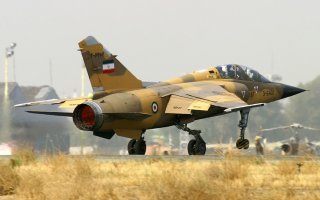Iran: Home to the Strangest Air Force on the Planet?
Tehran possesses a combination of rebuilt U.S.-supplied planes dating from the 1970s plus homegrown designs of highly varying value.
Here's What You Need to Know: Some of the “newest” warplanes in Iranian service are actually Soviet-made Su-22 Fitters of 1970s vintage.
Iran is an air power, relying on large numbers of heavily-armed warplanes to deter hostile neighbors and try to keep at bay the ships, stealth fighters and spy planes of the United States.
But Iran is also an isolated and embargoed state, barred from legally acquiring new airframes, parts and munitions from most foreign sources.
So over the four decades since its Islamic Revolution made it a pariah, Tehran has cobbled together one of the world’s most bizarre air forces—a combination of rebuilt U.S.-supplied planes dating from the 1970s plus homegrown designs of highly varying value and, most strangely of all, scores of aircraft essentially stolen from Iraq after they fled to Iran to escape American attack during the 1991 Gulf War.
Indeed, some of the “newest” warplanes in Iranian service are actually Soviet-made Su-22 Fitters of 1970s vintage, once operated by Iraq, ditched in Iran nearly twenty-three years ago, and now being slowly rebuilt and upgraded for another several decades of service. The Fitters could conceivably be more than seventy years old by the time they finally retire for good in 2040 or later.
Babak Taghvaee detailed the Persian state’s efforts to rebuild Iraqi Su-22s in a 2015 issue of Combat Aircraft magazine.
According to Taghvaee, no fewer than forty Iraqi Su-22s fled to Iran in January 1991 during the height of the U.S.-led aerial assault, their pilots steering the heavy swing-wing jets over the Iranian terrain they had once bombed during the Iran-Iraq War in the 1980s. Two Su-22s did not make it. American F-15s blasted them from the sky.
Some of the surviving Su-22s crashed-landed, others touched down safely. One pilot died when his Fitter struck a pole on landing. By the time the exodus ended, Iran hosted a mix of intact, damaged and totally wrecked Fitters among a total of more than 140 exiled Iraqi aircraft. Within a few years, Tehran had unilaterally claimed the “guest” planes as its own. Iran had not possessed Su-22s prior to the Iraqi jets’ arrival.
What followed was a twenty-year effort to restore the powerful jet bombers to front-line service. The Fitters are a natural fit for the Iranian air force, which operates hundreds of old Soviet planes and is especially in need of long-range ground-attack planes to deter the forces of the U.S. and the Arab Gulf States.
The former Iraqi Fitters were in bad shape, but Iranian military headquarters “insisted” that they all be repaired, according to Taghvaee. Technicians assigned to Iran’s Su-24 force apparently figured that the two swing-wing bombers had plenty in common, despite being totally different designs—and despite Iran lacking the right manuals. The technicians tried and failed to restore the Su-22s.
Ukrainian experts offered to fix ten Su-22s for $10 million apiece, but Tehran balked at the cost. The Iranian air force apparently did cough up $1 million for technical manuals from Ukraine—and by 1994 managed to get the ten jets in working condition.
Iranian Su-24 pilots, who had done some of their initial flight training on Su-20 simulators in the USSR, took the rebuilt jets out for some taxi runs. The results were not good. “The canopy of the airplane was not really sealed and the airplane was wobbling,” one pilot recalled.
Some of the ten “new” Fitters eventually flew, but a political purge of the air force in 1994 grounded them and most of Iran’s other warplanes. Tehran slowly reorganized the flying branch with loyal officers and, in 1997, ordered another attempt to restore the Su-22s. But the work was sloppy. “The project was stopped once again,” Taghvaee writes.
In the 2000s, Iran’s domestic aerospace industry made rapid gains and soon proved it could repair a wide range of old, foreign-made warplanes in addition to crafting new models (and at least one dramatic fake). In 2012, state industry began work on the surviving Su-22s, now numbering 35.
On Oct. 1, 2013, Amir Ali Haji Zadeh, head of the Iranian air force, announced that the Su-22s could now be reliably restored. The bombers would get new systems, including modern electronics and guided weapons. According to Taghvaee, Iran expected to receive thirty-five resurrected Fitters by 2020—nearly thirty years after they arrived in Iran as “guests.”
In fact, Tehran restored just ten Su-22s, according to Flight’s 2019 survey of world warplanes. They all fly for the Iranian Revolutionary Guards Corps militia.
David Axe was defense editor of The National Interest. He is the author of the graphic novels War Fix, War Is Boring and Machete Squad.
This article first appeared April 2020.
Image: Wikimedia Commons

